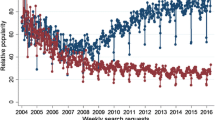Abstract
A model experiment is presented for thequantitative selection of relative scientometric impact indicators used in evaluating the scientific impact of papers. The Relative Subfield Citedness (Rw) indicator proved to be the most appropriate according to the criteria chosen. RW increases with the number of citations to the papers and, in contrast to other relative impact indicators, does not decrease if an author chooses to publish most of his papers in journals with large impact factors or if most of the citations to his papers are to the ones in journals with the largest impact factors.
Similar content being viewed by others
References
P. Vinkler, An attempt of surveying and classifying bibliometric indicators for scientometric purposes,Scientometrics, 13 (1988) 239.
M. J. Moravcsik, Some contextual problems of science indicators, In:A. F. J. Van Raan (Ed.),Handbook of Quantitative Studies of Science and Technology, North-Holland, 1988.
A. Schubert, A. Braun, Relative indicators and relational charts for comparative assessment of publication output and citation impact,Scientometrics, 9 (1986) 281.
P. Vinkler, Evaluation of some methods for the relative assessment of scientific publications,Scientometrics, 10 (1986) 157.
P. Vinkler, Bibliometric features of some scientific subfields and the scientometric consequences therefrom,Scientometrics, 14 (1988) 453.
P. Vinkler, Bibliometric analysis of publication activity of a scientific research institute, In:L. Egghe andR. Rousseau (Eds),Informetrics 89/90, Elsevier Science Publishers, 1990.
Per O. Seglen, Evaluation of scientists by journal impact, In:P. Weingart, R. Sehringer, M. Winterhager (Eds),Representations of Science and Technology, PSWO Press, Leiden University, 1992.
M. L. Raisig, Mathematical evaluation of the scientific serial,Science, 131 (1960) 1417.
E. Garfield,Citation Indexing. Its Theory and Application in Science, Technology and Humanities, Wiley, New York, 1979.
P. Vinkler, Possible causes of differences in information impact of journals from different subfields,Scientometrics, 20 (1991) 145.
P. Vinkler, Model of manifested communication through publications,Scientometrics, 31 (1994) 223.
P. Vinkler, Magic triangle for three relative impact indicators,Scientometrics, 21 (1991) 143.
P. Vinkler, Literature overlap measures for information pools of research teams, In:M. E. D. Koenig, A. Bookstein (Eds), Proceedings of the fifth Biennial Conference of the International Society for Scientometrics and Informetrics, 1995.
Author information
Authors and Affiliations
Rights and permissions
About this article
Cite this article
Vinkler, P. Model for quantitative selection of relative scientometric impact indicators. Scientometrics 36, 223–236 (1996). https://doi.org/10.1007/BF02017315
Received:
Issue Date:
DOI: https://doi.org/10.1007/BF02017315




